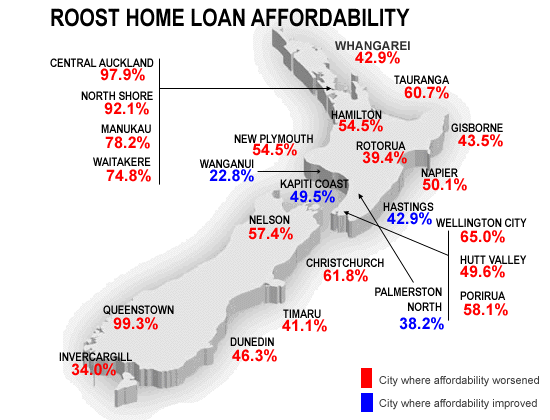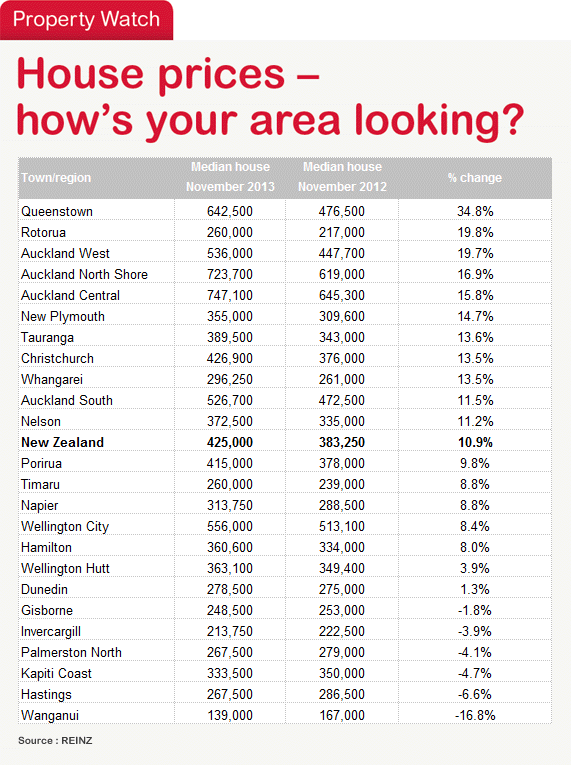
Home loan affordability deteriorated again across all of New Zealand's biggest cities in November to its worst level since August 2010 as house prices continued inflating and interest rates started rising.
The Roost Home Loan Affordability reports show affordability worsened in 20 out of 24 regions and in all of the South Island as a rise in median house prices to record highs more than offset small increases in income.
The Reserve Bank's high Loan to Value Ratio (LVR) speed limit has yet to slow house price inflation, but the bank reported this month it still expected it to reduce inflation by around 2.5 percentage points.
However it also increased its house price inflation forecasts because of a rise in net migration.

Affordability is also expected to be pressured in the year ahead as the Reserve Bank is expected to increase interest rates by as much as 1.25 percentage points and banks have already started lifting fixed mortgage rates.
"The Reserve Bank's speed limit and the higher interest rate forecasts are changing the equations for home buyers," said Roost Mortgage Brokers spokeswoman Colleen Dennehy.
"Banks have restructured the way they offer mortgages and their interest rates, which means borrowers need all the help and advice they can get from a broker," she said.
The Roost Home Loan Affordability reports show national affordability worsened to 60.6% in November from 58.2% in October after the national median house price rose to NZ$425,000 from NZ$407,525. The reports measure the percentage of after tax pay needed to service an 80% mortgage on a median priced house.
The Roost Home Loan Affordability report for November showed affordability for regular home buyers improved in Wanganui, Kapiti Coast, Palmerston North and Hastings, but worsened in every other region and city.
It was toughest for first home buyers on the North Shore in Auckland. It took 106.3% of a single median after tax income to afford a first quartile priced house on the North Shore in November.
Average fixed mortgage rates, which more than 50% of new borrowers now use, were flat in November, but have risen around 10 basis points in mid December.
Housing affordability has become a major economic and political issue over the last year. The Reserve Bank and Government agreed on a toolkit of 'macro-prudential' controls in May that would see the central bank impose limits growth in high loan to value ratio mortgages. Central and local governments are also moving to address housing supply shortages.
For first home buyers – which in this Roost index are defined as a 25-29 year old who buys a first quartile home – there was also a deterioration in affordability in most cities.
It took 49.7% of a single first home buyer's income to afford a first quartile priced house nationally, up from from 47.7% a month earlier. The most affordable city in New Zealand for first home buyers was Wanganui, where it took 14% of a young person's disposable income to afford a first quartile home. The least affordable was the North Shore of Auckland at 106.3%.
Any level over 40% is considered unaffordable, whereas any level closer to 30% has coincided with increased buyer demand in the past.
For working households, the situation is similar, although bringing two incomes to the job of paying for a mortgage makes life considerably easier. A household with two incomes would typically have had to use 39.9% of their after tax pay in November to service the mortgage on a median priced house. This is up from 38.3% in October.
On this basis, most smaller New Zealand cities have a household affordability index below 40% for couples in the 30-34 age group. This household is assumed to have one 5 year old child.
For households in the 25-29 age group (which are assumed to have no children), affordability nationally worsened to 24.0% of after tax income in households with two incomes required to service the debt, up from 23.6% the previous month.
Any level over 30% is considered unaffordable in the longer term for such a household, while any level closer to 20% is seen as attractive and coinciding with strong demand.
First home buyer household affordability is measured by calculating the proportion of after tax pay needed by two young median income earners to service an 80% home loan on a first quartile priced house.
---------------------------------------------------------------------------------------------------------------------------------------
Mortgage choices involve making a significant financial decision so it often pays to get professional advice. A Roost mortgage broker can be contacted by following this link »
---------------------------------------------------------------------------------------------------------------------------------------
No chart with that title exists.
Full regional reports are available below:


We welcome your comments below. If you are not already registered, please register to comment.
Remember we welcome robust, respectful and insightful debate. We don't welcome abusive or defamatory comments and will de-register those repeatedly making such comments. Our current comment policy is here.